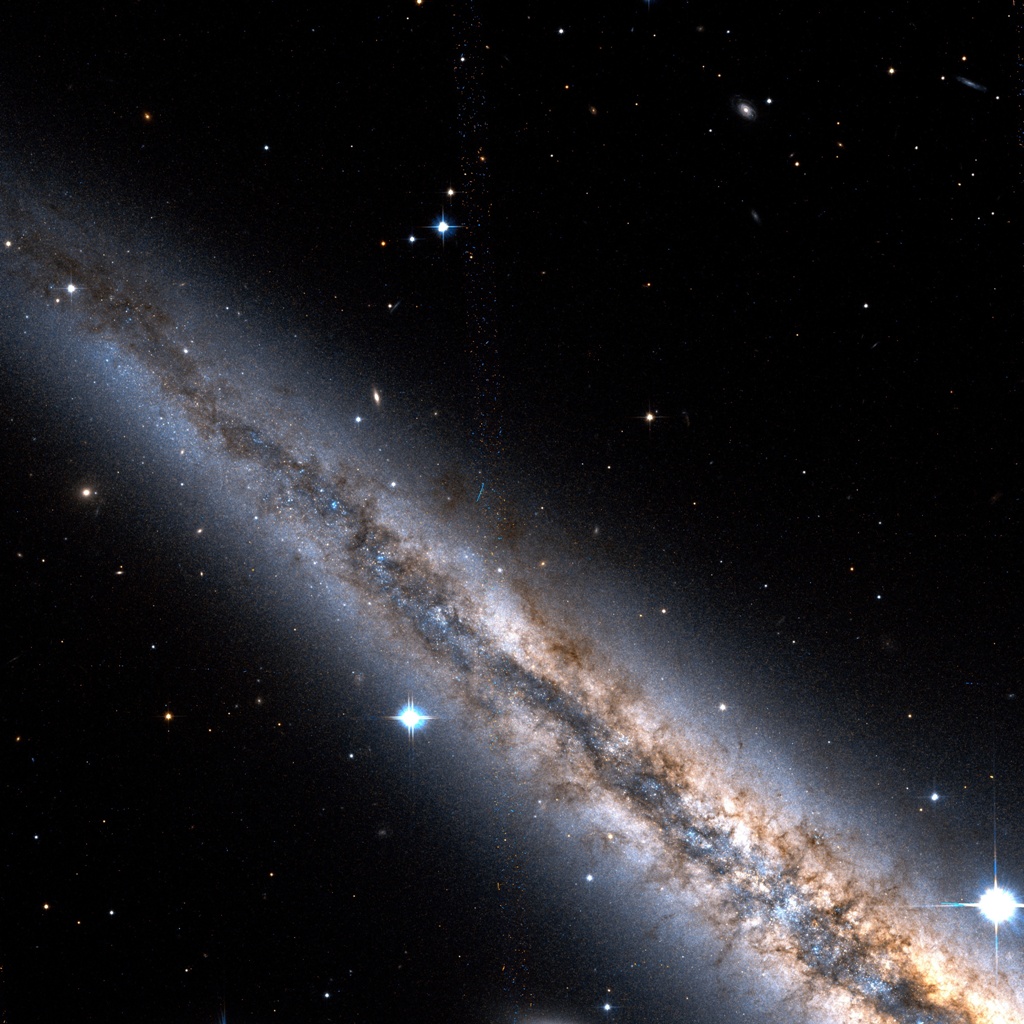Back to the subject of NGC 4565, a most interesting galaxy. (Aren't they all?)
I can't resist showing you two small and poorly resolved images of two edge-on galaxies, NGC 4565 and NGC 891:

NGC 4565. Photo:
Peter Bresseler.

NGC 891. Photo: Jimmy Walker.
Okay! Now we'll be looking at Hubble closeups of parts of their disks. Which disk is which?
Why, the closeup of NGC 4565 is at left, and the closeup of NGC 891 is at right. That wasn't so hard, was it?
Note the following:
1) NGC 4565 has a thinner and more elongated profile than NGC 891. You can actually see that the thick disk of NGC 891 - the disk that can be seen above and below the dust lane - is more puffed up in NGC 891 than it is in NGC 4565.
2) Note that in the picture of NGC 891, we can see huge columns of dust rising above and below the central dust lane in the lower right part of the picture. Note that there are bright blue star clusters in the dust lane where we see the tall "chimneys" of smoke. The columns of dust are undoubtedly remnants of violent supernovas.
3) Note that there are no such "chimneys" in the dust lane of NGC 4565. And while there are some small clusters of young blue stars in the disk, they are not prominent at all, and they don't seem to be associated with supernovas. Indeed, if a galaxy is going to be as flat as NGC 4565, there can't be much star formation in the disk. And in NGC 4565, there isn't.
NGC 4565 in ultraviolet.
Photo: GALEX.
That doesn't mean that there are no young stars at all in NGC 4565. We can actually see small numbers of blue stars scattered in the dust lane of the galaxy in the Hubble closeup of NGC 4565. Almost certainly, star formation is going on slowly and steadily in NGC 4565, leading to the continuous, slow creation of a massive star here and a massive star there. In the low-resolution picture of NGC 4565 in ultraviolet light at left, the entire dust lane glows blue from hot stars scattered there.
NGC 4565 is a huge galaxy. You can actually see from the enormously extended disk of it that it is much larger than NGC 891. According to
freestarcharts.com, the radius of NGC 4565 is 70,000 light-years, which would make the size of NGC 4565 140,000 light-years in diameter. That would make it much bigger than the Milky Way, whose optical disk is supposed to be some 100,000 light-years in diameter. freestarcharts.com also says that there are a trillion stars in NGC 4565. Well, I can believe it. Because not only is NGC 4565 huge, but it is yellow too, meaning that it must contain enormous numbers of small red and yellow stars. The B-V index of NGC 4565 is 0.840, which is relatively, although not tremendously, red.
(Okay... today's caption says that the disk of NGC 4565 is "only" 100,000 light-years in diameter. Whatever.)

M101.
Photo: Oriol Lehmkuhl and Ivette Rodríguez.
We can compare NGC 4565 with M101, which was
the APOD just a few days ago. According to
Wikipedia, the disk of M101 is 170,000 light-years in diameter, much larger than NGC 4565. Yes, but the color index of M101 is 0.450, which is tremendously blue. M101 contains astonishing numbers of bright blue OB stars, but how many small red stars it contains is an open question.
M101 and NGC 4565 are two very large galaxies. But while one is in the throes of tidal forces causing huge distortions of its disk, NGC 4565 sails through peaceful skies like a perfect needle of the heavens.
Ann
 NGC 4565: Galaxy on Edge
NGC 4565: Galaxy on Edge










